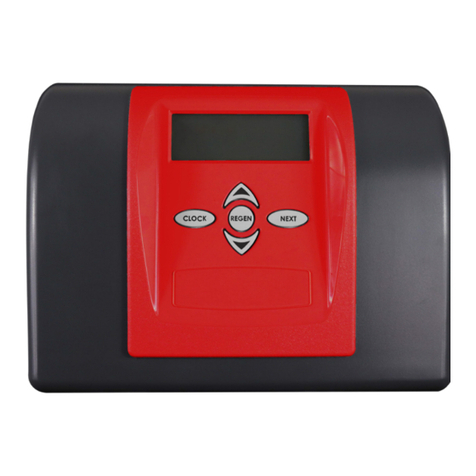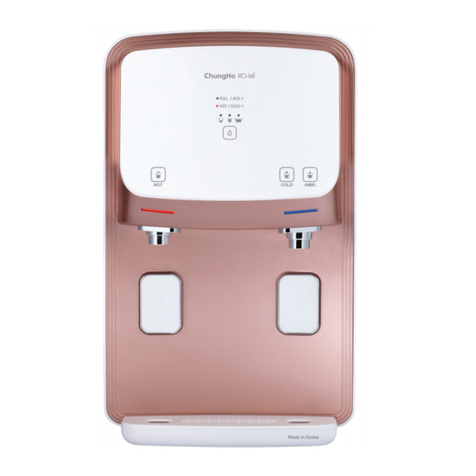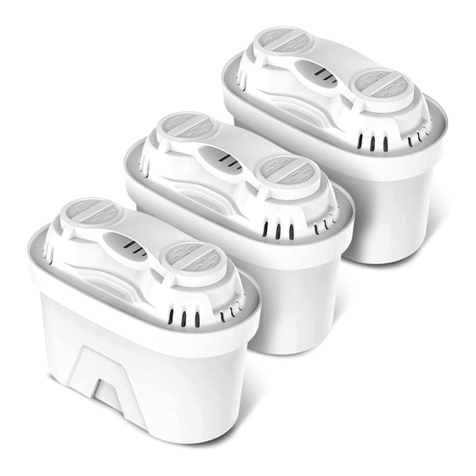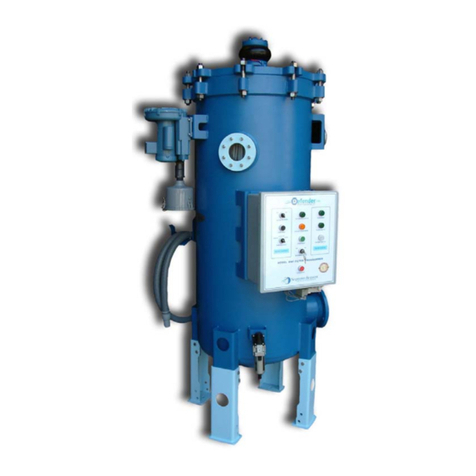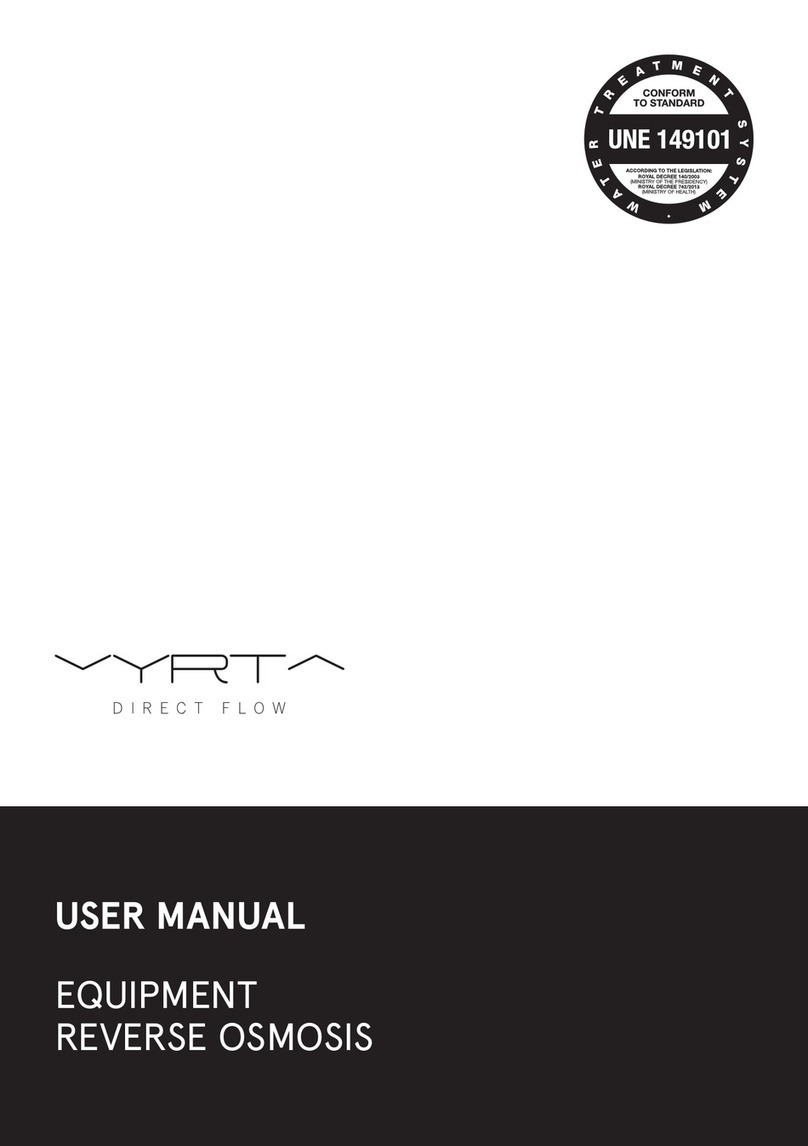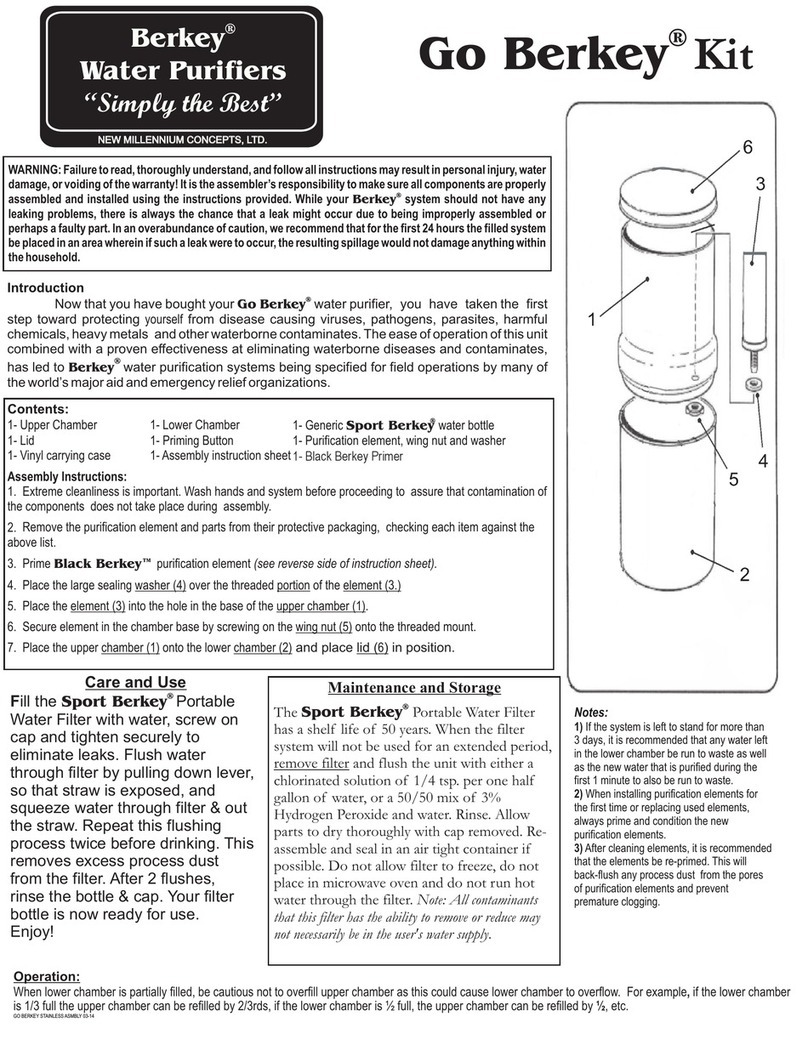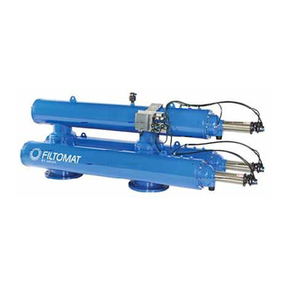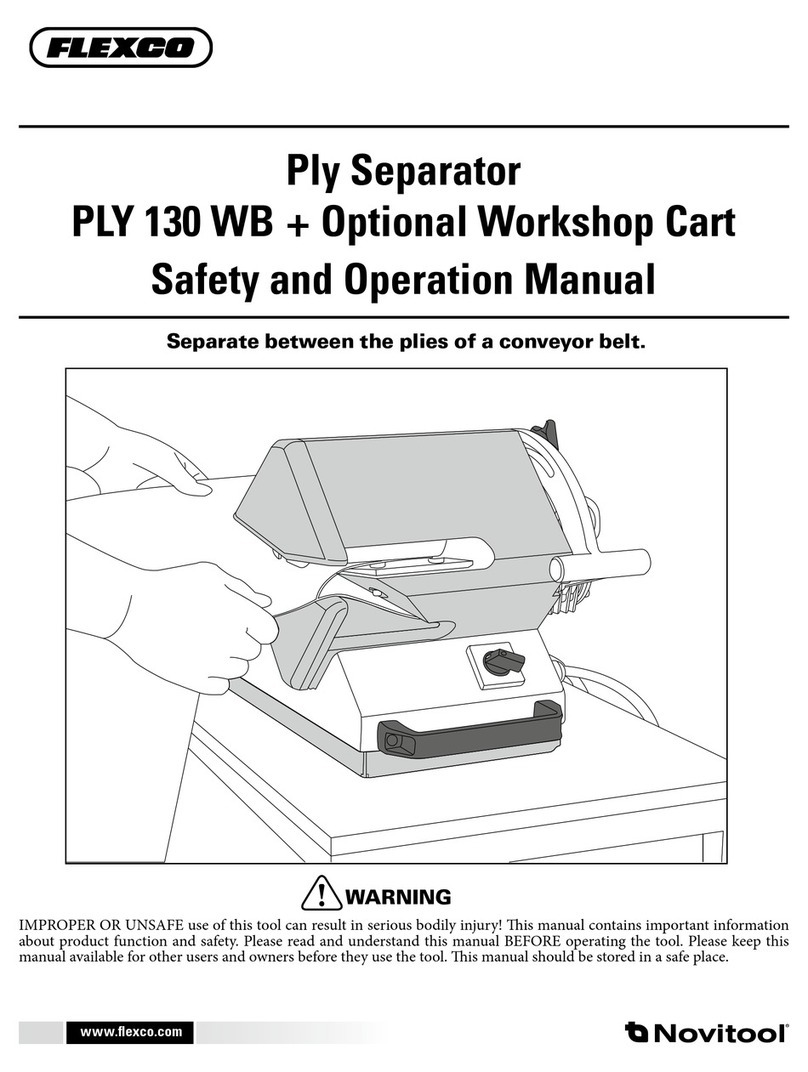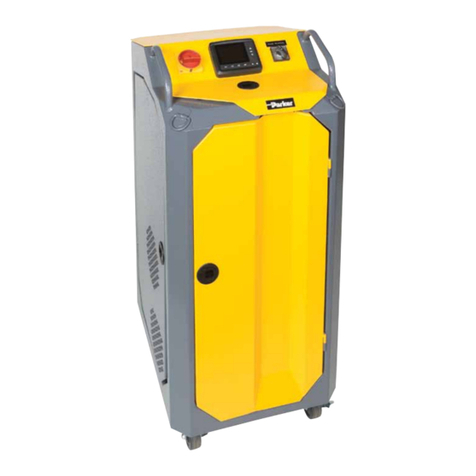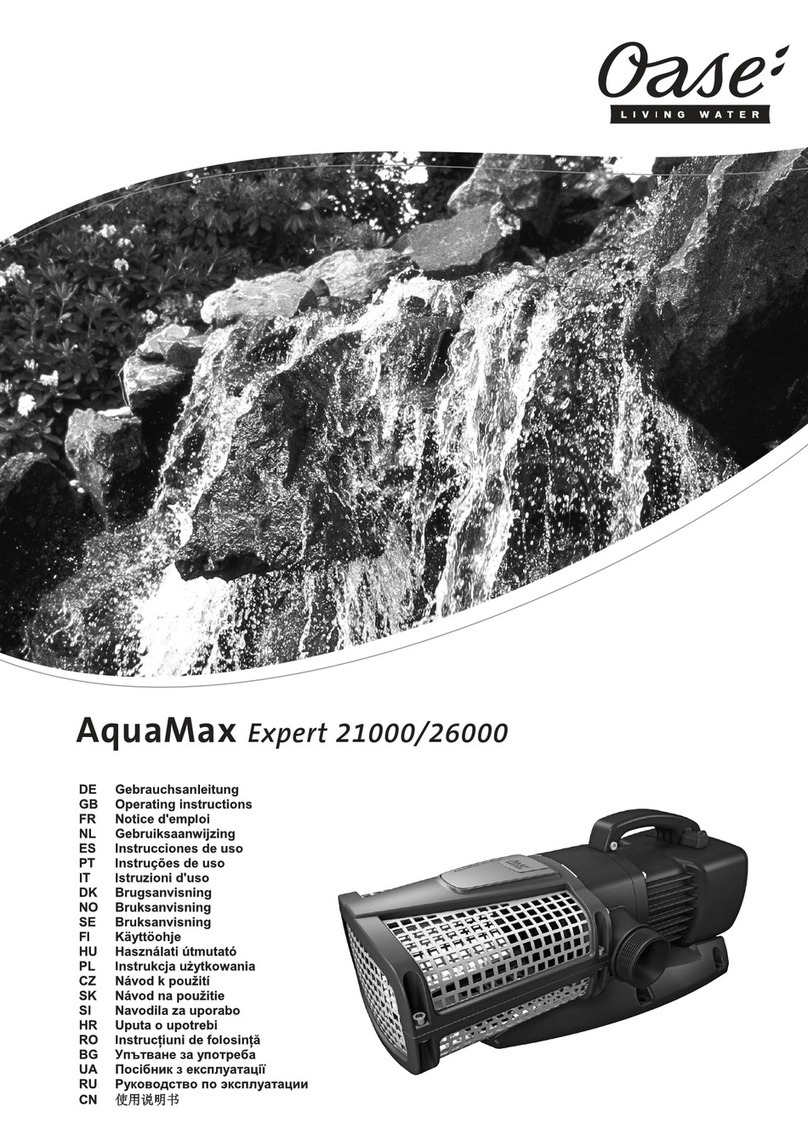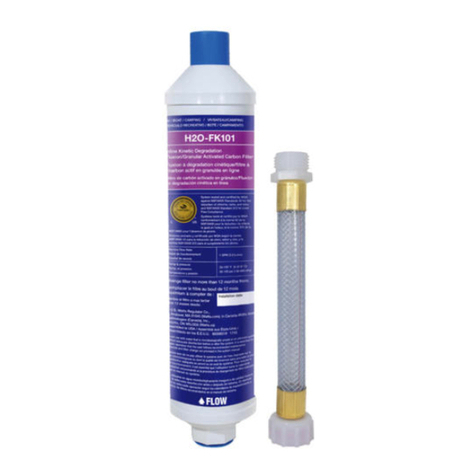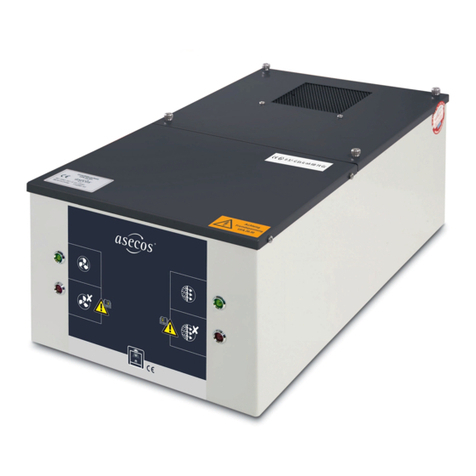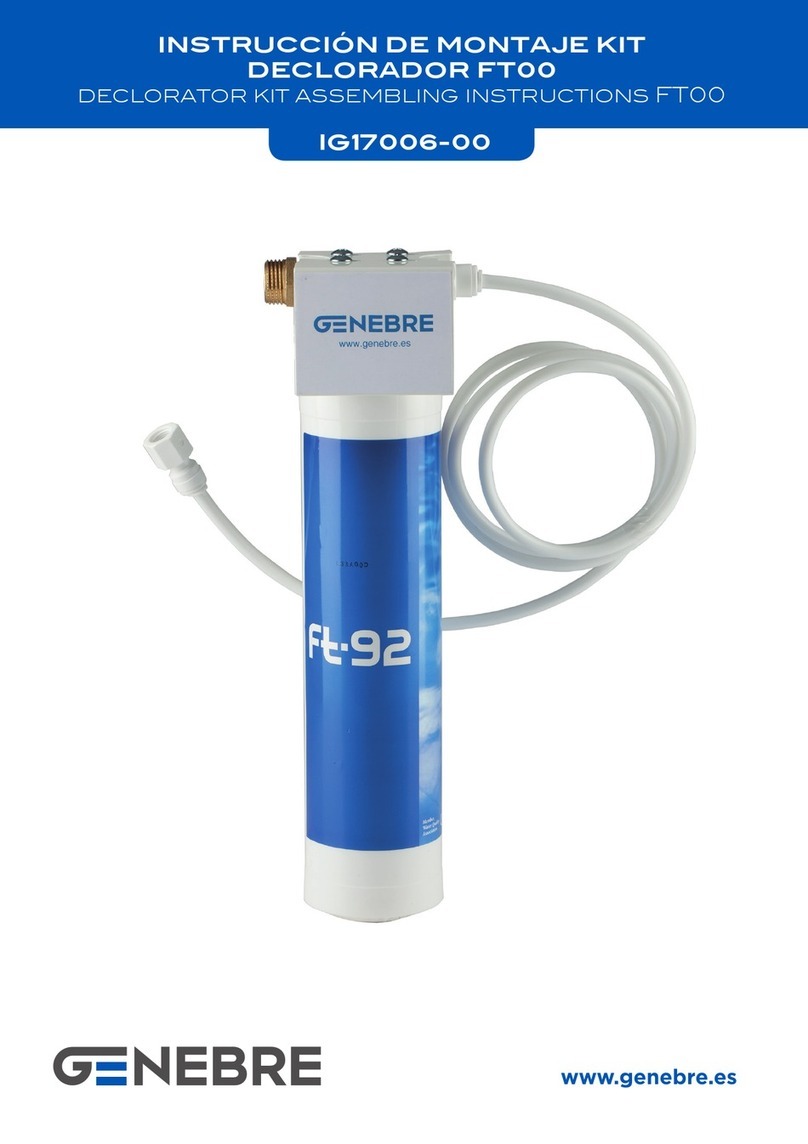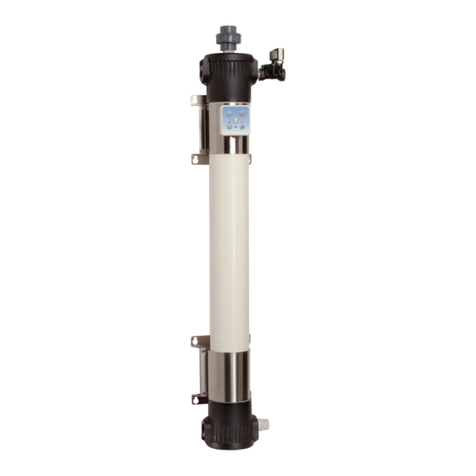Crusader CWS5-031 User manual

OWNERS MANUAL
Operation & Installation Instructions
CWS5-031, CWS5-061, CWS5-101, CWS5-151, CWS5-
201, CWS6-061, CWS6-101, CWS6-151, CWS6-201
www.crusaderwater.com

Congratulations on purchasing this ultraviolet disinfection system. By purchasing a Crusader Water
Systems UV Disinfection system you are receiving not only a high quality product but also peace of
mind. Protecting your water supply with a UV system gives you reassurance that your family will
have access to safe drinking water throughout your entire home with no chance of microbiological
contamination. This is chemical free process which is simple in its concept and effective in its
abilities to inactivate microorganisms present in the water supply. Simple maintenance, continuous
disinfection and ultimately safe water, Crusader makes it that easy.

3 | P a g e
TABLE OF CONTENTS
Safety Considerations........................................................................................... 4
Before You Begin .................................................................................................. 4
Water Quality Parameters: .................................................................................. 5
Assembly .............................................................................................................. 6
System Sizing ........................................................................................................ 6
Location................................................................................................................ 7
Installation............................................................................................................ 7
System Disinfection ............................................................................................ 11
Cleaning the Quartz Sleeve ................................................................................ 12
Operation ........................................................................................................... 13
Crusader5.0 & Crusader6.0 Controller .............................................................. 13
Crusader5.0 & Crusader6.0 Power-up Sequence .............................................. 14
Crusader5.0 Operational Screens ................................................................... 15
Crusader6.0 Operational Screens .................................................................... 16
Crusader6.0 % UV Intensity ............................................................................. 16
Crusader5.0 & Crusader6.0 Lamp Countdown Sequence ................................. 17
Crusader5.0 & Crusader6.0 Lamp Countdown Reset Sequence ....................... 18
Crusader5.0 & Crusader6.0 Failure Modes ....................................................... 18
Crusader5.0 & Crusader6.0 QR Codes .................................................................. 19
Crusader5.0 & Crusader6.0 Expansion Modules .................................................. 20
Warranty Registration ........................................................................................ 21
Crusader6.0 Specifications.................................. Error! Bookmark not defined.22
Crusader5.0 Specifications...................................................................................23
Limited Warranty Statement: ............................................................................ 24

4 | P a g e
Safety Considerations
Although your UV system has been manufactured to the highest safety standards, extreme care
must be followed when operating and/or maintaining your system.
1. Whenever you are servicing this equipment, always disconnect the power cord from the
electrical outlet.
2. As the energy given off by the UV lamp can be harmful to your eyes and skin, NEVER
look directly at an illuminated UV lamp without adequate eye protection and always
protect your skin from direct exposure to the UV light.
3. To ensure the system provides adequate disinfection, ALWAYS replace any component
(lamp and sleeve) with a genuine manufacturer’s replacement part.
4. Do not operate the unit if it has any damaged or missing components.
5. To avoid possible electrical shock, use only with a properly grounded electrical outlet.
6. Never perform any maintenance to the system unless you are comfortable in doing so.
Contact the manufacturer for service instructions if required.
7. Do not use this system for any purpose other than what it was intended for. Misuse of
this system could potentially cause harm to the user.
8. Your system is intended to be installed indoors and away from leaking plumbing. DO
NOT plug the unit in if the system or any of the components are wet.
9. The disinfection system should be directly installed into a ground fault circuit interrupter
(GFCI). If the use of an extension cord is required, the cord must be manufactured with a
minimum of 16 gauge wire and care should be taken to avoid potential tripping hazards.
10. We recommend that a licensed plumber or certified technician perform the installation
Before You Begin
Before you begin, you’ll need the following:
Tools
Pipe cutter, hacksaw or other specialized tools required to cut into your existing
plumbing (e.g. if you have PEX piping)
Soldering tools (torch, flux, emery cloth and solder)
Wrench (for tightening fittings)
Other Materials
Inlet/outlet connections
Teflon™ tape

5 | P a g e
Water Quality Parameters:
UV disinfection is extremely effective against microorganisms but only if the UV light can pass
through the water it needs to treat. This means that the quality of your water is very important in
order to ensure complete disinfection.
It is imperative that you have your water tested for at the least the parameters listed below. If the
water exceeds the listed parameters Crusader strongly recommends that appropriate pretreatment
equipment be installed (pretreatment will depend on parameters being treated):
Hardness: <7 gpg (120 mg/L) –if hardness level is 7 gpg or
slightly below the quartz sleeve must be cleaned
periodically in order to ensure efficient UV
penetration; if above the water must be softened
Iron (Fe): <0.3 ppm (0.3 mg/L)
Manganese (Mn): <0.05 ppm (0.05 mg/L)
Turbidity: < 1 NTU
Tannins (organics): <0.1 ppm (0.1 mg/L)
UVT (transmittance): >85% (Please contact Crusader if water has a UVT
that is less than 80% for pre-treatment
recommendations)
You can have your water tested at a private analytical laboratory or by your local dealer. It is
always recommended to install pre-filtration of at least 5 microns prior to a Crusader UV
disinfection system.

6 | P a g e
Assembly
Step 1: Unpack the system and ensure all the components are included with the system. Your
system is shipped with the following components:
System Sizing
All Crusader UV systems are rated for a specific flow rate under specific water quality parameters.
The equipment has been designed to ensure that the appropriate dose will be delivered provided
all parameters are followed. PLEASE NOTE that the flow rate for each system can be higher or lower
than what the system is rated for however this will change the dose level that the system will
deliver. A lower flow is not a concern as the dose will increase however a higher flow rate will
decrease the dose and therefore compromise the microorganism inactivation.
It is important to know the maximum flow rate that your water system delivers. If you do not have
this information you can simply fill a 1 gallon bucket with water and time how long it takes to fill up.
This will be the maximum flow rate for the home. Choose a Crusader system that is suitable.
PLEASE NOTE: It is always better to oversize your system then to undersize. For example, if your
pump delivers 8 gpm it is recommended to install any of the Crusader 10 gpm systems. There will
come a time where your home is using water at the pump’s maximum capacity.

7 | P a g e
Figure 1. Lamp Removal
Spacing
Location
Step 1: Find a suitable location to mount the
UV reactor and the accompanying controller. In
choosing your location ensure the controller is
located within 5 feet of a ground fault circuit
interrupter (GFCI) and that there is easy access to
the main cold water line prior to any branch lines
and before the hot water heater. If you have any
other water treatment equipment, such as a
softener or water filter, ensure that the UV is the
last piece of treatment equipment. PLEASE
NOTE: All Crusader UV disinfection systems are
intended for indoor use only as they should not
be exposed to the elements.
Step 2: Your system includes mounting
hardware for both the UV reactor and the
controller. If the supplied fasteners are not
compatible with the structure in which you are
mounting the device, please ensure you use the
correct fasteners.
Step 3: To facilitate lamp removal, ensure
there is enough space at the lamp connector end
to safely remove the UV lamp and/or quartz
sleeve (a space equal to the length of the unit will
suffice) (see Figure 1.).
Installation
Step 1: The UV disinfection system should
always be the last piece of treatment before the
water branches off to the hot and cold water lines
if the intent is for Point of Entry (POE) (see figure
2). If the intent for the UV system is for Point of
Use (POU) the system should be the final step before the
faucet.
Step 2: Crusader strongly recommends that a 5 micron filter be installed before the UV system
for a final polishing step before the water is disinfected.
Step 3: The reactor can be installed either horizontally or vertically using the clamps provided,
however vertical installation is the preferred method with the inlet at the bottom (lamp connection
at the top) as it allows any air that may be in the lines to be easily purged from the system.
Step 4: If the water supply flow rate is unknown, it is recommended that you use a flow
restrictor so that the rated flow of your particular Crusader system is not exceeded and the UV dose
is not compromised. The flow restrictor should be installed on the outlet port of the reactor.

8 | P a g e
Step 5: It is strongly recommended to have a licensed plumber connect the UV reactor to the
water supply and may be a requirement depending on where you are located. If you are attempting
this yourself, ensure you have all the necessary tools and fittings to accomplish this task.
Step 6: Although there are many methods of installation, this manual will provide a
recommended procedure using copper plumbing and standard soldering methods. Crusader
recommends the use of unions, a by-pass assembly and shut-off valves as this will allow you to
isolate and remove the UV reactor if necessary (this method is a recommended method only
however it allows for the maximum convenience but it requires extra components and more time
for installation. Please refer to Figure 3 for the recommended installation.
Figure 2. Recommended POE Installation
Figure 3. Recommended Installation

9 | P a g e
Step 7: Before you cut into the cold water line, measure and cut all piping as per the
recommended layout. Once all the components are ready, start by installing the female adapters
onto the ports of the reactor. To ensure a proper seal, the use of Teflon™tape is recommended on
all threaded connections.
Step 8: Next solder all the assembly together, including ball valves and unions and finally
connected the by-pass assembly to the cold water feed line (water in and water out).
Step 9: You can now gently remove the quartz sleeve from its packaging being VERY careful not
to touch the length with your hands. The use of cotton gloves (not included) is recommended for
this procedure as oils from our hands can leave residue on the sleeve and lamp which can
ultimately block the UV light from getting to the water. In the package, you will find a lubricated o-
ring. Place the o-ring over the open-end of the sleeve as shown in Figure 4.
Figure 4. Quartz Sleeve Installation
Step 10:Carefully slide the sleeve into the reactor until you can feel it hit the opposite end of the
reactor. Slightly push the sleeve in to feel it lock into the spring inside the reactor. Ensure that the
o-ring is butted up against the reactor. Assemble the provided gland nut onto the threaded end of
the reactor and tighten. The gland nut has a positive stop to avoid over-tightening, hand tighten
ONLY. Install the provided stainless steel compression spring inside the quartz sleeve. This spring
simply sits in the bottom of the quartz sleeve and works with the lamp and lamp connector to
create the proper lamp alignment. PLEASE NOTE: DO NOT install a UV lamp inside the quartz sleeve
without the sleeve spring in place.
Step 11: (Applies only if you have a UV sensor… Crusader6.0)The UV sensor for the system is
packaged in a separate plastic bag. Carefully remove the sensor from its packaging and insert the
sensor into the UV sensor port (remove the protective cap on the UV reactor first). The sensor can
only go in one way. Ensure that the flat portion of the UV sensor matches up with the half metal lip
on the sensor port (flat portion should face the lamp connection end) (see Figure 5.). Ensure that
the sensor is fully seated in the sensor port and then tighten (turning clockwise) the sensor nut.
PLEASE NOTE: DO NOT over tighten the nut as this could damage the Teflon sensor body. Plug the
male connector into the IEP port located on the right side of the controller, Figure 6, (make sure the
controller is not plugged in as the sensor MUST be attached before power is applied to the
controller.)

10 | P a g e
Figure 5. UV Sensor Installation Figure 6. IEP Connection
Step 12: The reactor is now ready for water flow. When all plumbing connections have been
completed you should check for any possible leaks. Slowly turn on the water supply and check for
leaks. Make sure the by-pass valves are functioning properly and that the water is flowing through
the reactor. The most common leak is from the o-ring not making a proper seal on the reactor. If
this is the case turn the water off, drain the reactor, remove the o-ring, dry it and reapply silicon
grease. Replace o-ring ensuring that it is properly sealed against the reactor and check again for
leaks.
Step 13: The controller can now be mounted on the wall. The controller should always be above
or beside the reactor to ensure that no moisture can deposit on any of the connections (see Figure
2.). Always mount the controller vertically. For safety purposes the controller should be connected
to a ground fault circuit interrupter (GFCI) (also known as a ground fault interrupter (GFI)).
Step 14: You can now remove the UV lamp from its packaging being careful not to touch the lamp
quartz with your hands. Again, the use of cotton gloves is recommended to avoid deposited oils on
the lamp glass. Always hold the lamp by the ceramic ends. With the lamp outside of the reactor,
affix the UV lamp to the lamp connector as shown in Figure 7.
Figure 7. UV Lamp Connection
Step 15: Carefully insert the UV lamp into the reactor sliding it inside the quartz sleeve located
inside the reactor (do not drop the lamp into the reactor). Affix the lamp connector into the gland
nut by inserting the connector into the nut and turning the connector approximately ¼ turn to lock
the connector to the gland nut.

11 | P a g e
Figure 8. Quick Disconnect Connector
Step 16: Affix the captive ground screw to the ground lug on the UV reactor to ensure proper
grounding continuity.
Figure 9. Ground Screw Connection
Step 17: Your system is now ready to be plugged into the appropriate GFCI protected outlet. Plug
the unit in and refer to the “System Disinfection” section before any water is allowed to flow
through the system.
System Disinfection
Now that the system is installed you will need to disinfect the lines throughout the entire home or
facility. To accomplish this, please follow these simple steps:
Step 1: Before performing this task, check to make sure that there are no “dead ends” in the
lines throughout the home as these can harbor bacteria. Also ensure that the UV system is
powered-up and ready for operation before you start this disinfection process.
Step 2: Remove the cartridge from the filter sump and fill with 1-2 cups of household bleach
(most household bleaches are 5.25% chlorine). Replace filter sump and slowly turn on the water
supply.

12 | P a g e
Step 3: Go to each location in the home or facility (including outdoor taps) and run some water
until chlorine can be detected (by smell). Ensure all faucets, dishwasher, shower heads, washing
machine, toilets, showers, refrigerators, etc. are all checked. Once the chlorine is detected at each
location close all faucets and let the chlorine sit in the lines for a minimum of 30 minutes.
Step 4: After 30 minutes, reinstall the filter cartridge into the filter sump and then flush the
chlorine solution by opening all faucets and let them run until chlorine can no longer be detected
(by smell). Your home has now been completely disinfected with your Crusader UV system ready to
inactivate any microorganisms that enter the home.
PLEASE NOTE: This procedure must be performed following any time the UV is shut down for
service, without power, or is inoperative for some reason in order to avoid possible contamination
of the water lines.
Cleaning the Quartz Sleeve
Depending on the water quality, the quartz sleeve may require periodic cleaning. At a minimum,
the quartz sleeve should be cleaned on an annual basis. The following steps outline a basic cleaning
procedure.
Step 1: If the system has an inlet shut-off valve, shut this valve off to prevent water flow
through the system. If there is no inlet shut-off valve, turn off main water inlet valve (and turn of
water pump if you have one).
Step 2: Disconnect power cord of UV system from electrical outlet.
Step 3: Release water pressure by opening a downstream faucet and close the outlet shut-off
valve if the installation incudes one (if there is no outlet shut-off valve, be prepared for water
leakage from the system as the head pressure in the system will cause water to flow back through
the outlet plumbing and through the reactor).
Step 4: Remove the captive ground screw from the ground lug on the UV reactor.
Step 5: Remove the lamp connector from the reactor (gland nut) by pushing the lamp connector
in and turning it ¼ turn counter-clockwise (gently pull on the lamp cable to ensure the connector is
seated properly).
Step 6: Pull lamp out of reactor still attached to connector.
Step 7: Remove the gland nut from the reactor exposing the end of the quartz sleeve.
Step 8: Carefully remove the quartz sleeve by gently twisting and pulling the quartz sleeve out
of the reactor and remove the o-ring.
Step 9: Using a soft, lint-free cloth or towel wipe the sleeve down using CLR® or LIME-A-WAY®
(or other commercial scale cleaner) to remove any scaling or iron deposits that may be on the
outside of the quartz sleeve. Be careful not to get any moisture or liquids on the inside of the
sleeve.
Step 10: Wipe the sleeve with separate dry cloth.
Step 11: Once the sleeve is cleaned replace the o-ring and slide the sleeve back into the reactor
following the steps outlined on page 9 of the manual.

13 | P a g e
Cleaning the UV Sensor
Depending on the water quality, the UV sensor may require periodic cleaning. At a minimum, the
UV sensor should be cleaning on an annual basis. The following steps outline a basic cleaning
procedure.
Step 1: If the system has an inlet shut-off valve, shut this valve off to prevent water flow
through the system. If there is no inlet shut-off valve, turn off main water inlet valve (and turn of
water pump if you have one).
Step 2: Disconnect power cord of UV system from electrical outlet.
Step 3: Release water pressure by opening a downstream faucet and close the outlet shut-off
valve if the installation incudes one (if there is no outlet shut-off valve, be prepared for water
leakage from the system as the head pressure in the system will cause water to flow back through
the outlet plumbing and through the reactor).
Step 4: Place something under the reactor to catch any water that may come out of the reactor
during the removal of the UV sensor.
Step 5: Unscrew (counterclockwise) sensor nut from the reactor and pull the sensor slowly out
of the sensor port.
Step 6: Holding the sensor in your hand wipe the flat portion (sensor face) of the sensor with
isopropyl alcohol using a clean lint-free cloth.
Step 7: Replace sensor as per instructions on page 9 of the manual.
Operation
The Crusader system comes with a feature laden controller that incorporates both the lamp driver
(ballast) and control features in one water-tight case. CAUTION: Prior to performing any
maintenance on your UV system, you must always disconnect the power.
Crusader5.0 & Crusader6.0 Controller
This controller features a power factor corrected, constant current lamp
driver with a universal power input. A full colour LCD screen provides
the user with a detailed description of the system’s performance in
addition to providing any applicable fault messages and system
diagnostics. The controllers used in both the Crusader5.0 and Crusader6.0
are identical. The difference is that the Crusader6.0 series of products
includes a UV intensity monitor. All Crusader5.0 and Crusader6.0
controllers include an “infinite expandability port” located on the right
side of the controller. Simply plug in an optional UV sensor module into
the expandability port of a Crusader5.0 controller and the system will
now monitor the UV intensity of the system!

14 | P a g e
Crusader5.0 & Crusader6.0 Power-up Sequence
Upon start up, the 5.0 & 6.0 controller will run through a diagnostic start-up and the sequence will
be displayed as follows on the colour LCD:
Next, the controller checks for the installation of any optional modules that may be installed on the
system. It first checks to see if a module is installed and then either initializes the module to
function with the controller or returns a “not detected” screen and moves on to the next module.
The screens will appear as follows:
UV Sensor
Module Check
Solenoid
Module Check
4-20 mA
Module Check

15 | P a g e
Ethernet
Module Check
Remote Alarm
Module Check
Once the controller has finished checking for the installation of all available modules a single screen
is displayed showing which specific modules are installed and activated on this particular system.
Please Note: If the corresponding module icon is not displayed on this screen, then that module is
not installed on this system. If you believe this module is installed correctly, recheck the applicable
connections to ensure a solid connection point and then restart the controller. The controller then
continues to optimize the lamp efficiency by waiting 60 seconds to allow the lamp to reach its
optimum output. Finally, a final “start-up complete” screen is displayed. These screens will appear
as follows:
Crusader5.0 Operational Screens
On Crusader5.0 systems (without the UV monitor), the default screen shows the Crusader Home
Screen. At any point during operation the user is able to scroll through the Crusader Home Screen,
Lamp life remaining and QR Code/Contact Info screens by simply pressing the button located on
the front of the controller.

16 | P a g e
Crusader6.0 Operational Screens
On systems that have the UV module installed (and on all Crusader6.0 systems), the default screen
shows the % UV Intensity. At any point during operation the user is able to scroll through the % UV
Intensity, Lamp life remaining and QR Code screens by simply pressing the button located on the
front of the controller.
Crusader6.0 % UV Intensity
If your system is equipped with a UV sensor the % UV Output screens will indicate the level of UV
intensity that is being detected within the reactor by the sensor. This will always be visible on the
Home Screen of the controller. Things that can affect the % UV Output are poor water quality,
scaling of the quartz sleeve and/or sensor, lamp failure, expired lamp life and sensor failure. The
following screens show the % UV Output dropping on a monitored system.

17 | P a g e
Once the UV output drops below 56%, the numbers and warning sign switch to red and a 15 second
intermittent audible chirp is given off by the ballast. When the output drops below 51%, the display
switches to a solid red and a constant audible signal is provided. The screens alternate between this
solid red screen and another screen indicating “water may be unsafe for consumption”. At this
point, the controller also provides a signal to de-activate the solenoid valve, shutting off the flow of
water if a solenoid valve is installed on the system.
Crusader5.0 & Crusader6.0 Lamp Countdown Sequence
The Crusader5.0 & Crusader6.0 counts down the number of days until a lamp change is required. The
operation is as follows:
Once the lamp has seven days remaining until a lamp change is required, the screen changes to a
yellow caution screen. At this point, an audible chirp is given off by the ballast to draw your
attention to the pending lamp change condition. When the controller passes the zero day
threshold, the screen changes to solid red and cycles between a red “lamp expired” screen and a
“water may be unsafe for consumption” screen. The same intermittent audible chirp is heard
throughout this lamp expired sequence.
At any point during this sequence, the audible chirp can be deferred by holding the controller
button down for a period of five seconds. The screen shown below will appear for five seconds
indicating that the audible defferal has been activated and then the system switches back to the
current lamp change or lamp expired screen. This audible deferral will last for seven days after
which then the alarm will sound once again. This audible deferral feature can be activated as many
times as you wish. PLEASE NOTE: During the condition of lamp expiration and audible deferral, the
water may be unsafe for consumption and should not be consumed without another form of
disinfection.

18 | P a g e
Crusader5.0 & Crusader6.0 Lamp Countdown Reset Sequence
After changing the lamp on the Crusader5.0 & Crusader.0 systems, the controller must be reset in
order for the system to begin its countdown function on the newly installed lamp. To perform this
reset, you must firmly depress the button on the front of the controller and then manually plug the
power cord back into the wall outlet initiating power to the unit. Keep holding down the button for
five seconds until you hear an audible chirp indicating the controller has reset the internal timer.
Release the switch and the lamp countdown feature has now been reset. The following two screens
will be displayed during this process.
Crusader5.0 & Crusader6.0 Failure Modes
The Crusader controller continuously monitors your UV system and if there is a problem with the
system the controller will provide both a visual and audible signal indicating the specific fault that
may be adversely affecting the operation of your system. The fault conditions are listed in a priority
sequence as follows:
LAMP FAILURE: If at any time during the operation of the
system, the UV lamp fails to be illuminated, the controller will
return both an audible and visual signal indicating lamp failure. In
addition, a constant audible buzzer will sound during lamp failure.
UV SENSOR FAILURE: Assuming the system has a UV Sensor
installed, if at any time during the operation of the system, a UV
sensor fails, the controller will return both an audible and visual
signal indicating sensor failure. For sensor failure, the controller
will cycle between “sensor failure” and “water may be unsafe for
consumption” screens as an added precaution. In addition, a
constant audible buzzer will sound during sensor failure.

19 | P a g e
SOLENOID MODULE FAILURE: Assuming the system has an
optional Solenoid Module installed, if at any time during the
operation of the system, a solenoid valve fails to operate, the
controller will return both an audible and visual signal indicating
solenoid failure. In addition, an intermittent (15 sec) audible
buzzer will sound during solenoid failure.
4-20 mA MODULE FAILURE: Assuming the system has an
optional 4-20 mA Module installed, if at any time during the
operation of the system, a 4-20 mA module fails, the controller
will return both an audible and visual signal indicating a 4-20 mA
failure. In addition, an intermittent (15 sec) audible buzzer will
sound during a 4-20 mA failure.
REMOTE ALARM MODULE FAILURE: Assuming the
system has an optional Remote Alarm Module installed, if at any
time during the operation of the system, a remote alarm module
fails, the controller will return both an audible and visual signal
indicating remote alarm failure. In addition, an intermittent (15
sec) audible buzzer will sound during remote alarm failure.
ETHERNET MODULE FAILURE: Assuming the system has an
optional Ethernet Alarm Module installed, if at any time during the
operation of the system, an Ethernet module fails, the controller
will return both an audible and visual signal indicating Ethernet
failure. In addition, an intermittent (15 sec) audible buzzer will
sound during Ethernet failure.
Crusader5.0 & Crusader6.0 QR Codes
A QR code (abbreviated from Quick Response code) is a type of matrix barcode (or two-dimensional
code) first designed for the automotive industry. Crusader uses the QR code to store a link to a
specific page on our website. Users with a camera phone equipped with the correct reader
application can scan the image of the QR code and over a wireless network connect to a Crusader
web page in the phone's browser. Crusader’s QR webpage has information on how to purchase
replacement components as well as a helpful video directory on system servicing (i.e. How to
change a UV lamp or quartz sleeve). To access the QR code on the Crusader5.0 or Crusader6.0
controller simply press the control button twice and the QR code screen will appear as follows:

20 | P a g e
Crusader5.0 & Crusader6.0 Expansion Modules
As shown earlier in this manual, the Crusader5.0 and Crusader6.0 controller incorporate an “Infinite
Expandability Port” (IEP) on the controller. It is through this port and via a custom communication
protocol that the UV sensor and all expanison modules are connected. Each module (including the
sensor) comes with both a male and female connection. To activate the device, you simply need to
connect the first device (does not matter which device it is) to the controller and all subsequent
devices are then connected into the female end of the other device. This “daisy chain” method
allows for a truly modular approach and is extremely user friendly. An example of this “daisy chain”
is shown below.
The following optional expansion modules are available for use on your Crusader5.0 and Crusader6.0
controllers. Contact your authorized distributor for purchasing information.
REMOTE ALARM MODULE: Allows for a
signal to be connected to a remote monitor such
as a buzzer, light, alarm system, PLC, etc., via a
pair of contacts. In normal operation the OK and
COM contacts will be connected, and in a fault
condition (Low UV, Lamp fail, Power Fail), the
Fault and COM contacts will be connected.
Maximum Contact Rating is 1A-120VAC/VDC
(uses 16-22 AWG).
SOLENOID CONNECTION MODULE:
Allows the integration of a NORMALLY CLOSED
line voltage solenoid valve. Simply affix the
module's supplied bare lead cord to the solenoid
valve, connect the power cable to the electrical
outlet, and the male IEP connector to the female
IEP port on the controller. PLEASE NOTE: When
this device is connected to a Crusader5.0 system
(without the UV module), then the solenoid will
close on a lamp failure mode only. When used on
a Crusader6.0 system, the solenoid will close when
the UV level drops below 50%. Also note that in
cases where emergency use of untreated water is
required, the controller can be placed into a
manual override mode allowing for the flow of
water in an alarm condition.
This manual suits for next models
8
Table of contents
Other Crusader Water Filtration System manuals
